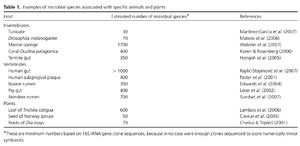The Hologenome Theory of Evolution
Introduction
The hologenome theory is a postulate put forth in 2007 by Eugene Rosenberg and Ilana Zilber-Rosenburg stating that the object of genomic natural selection is not a single organism, but the organism and its microbial communities (Rosenburg et al., 2007). This theory was originally based on the pair’s observations of Vibrio shiloi-mediated bleaching of the coral Oculina patagonica (Rosenburg & Zilber-Rosenburg, 2008); since its first introduction, the theory has been promoted as a fusion of Lamarckism and Darwinism (Rosenburg, Sharon, and Zilber-Rosenburg, 2009) and expanded to all of evolution, not just that of corals (Rosenburg & Zilber-Rosenburg, 2011). Recent research by the Rosenburg lab suggests that commensal bacteria play a role in mate choice by the fruit fly, Drosophila melanogaster, further supporting the hypothesis that greater genetic trends are determined by symbiotic microbiota (Sharon et al., 2010).
Double brackets: [[
Filename: PHIL_1181_lores.jpg
Thumbnail status: |thumb|
Pixel size: |300px|
Placement on page: |right|
Legend/credit: Electron micrograph of the Ebola Zaire virus. This was the first photo ever taken of the virus, on 10/13/1976. By Dr. F.A. Murphy, now at U.C. Davis, then at the CDC.
Closed double brackets: ]]
Other examples:
Bold
Italic
Subscript: H2O
Superscript: Fe3+
The Coral Probiotic Hypothesis
Include some current research in each topic, with at least one figure showing data.
The Hologenome
Include some current research in each topic, with at least one figure showing data.
Larmarckism vs. Darwinism
Include some current research in each topic, with at least one figure showing data.
Microbes' Influence on Mate Selection
Include some current research in each topic, with at least one figure showing data.
Conclusion
Overall paper length should be 3,000 words, with at least 3 figures.
References
Edited by Rachel Martin, student of Joan Slonczewski for BIOL 238 Microbiology, 2009, Kenyon College.

